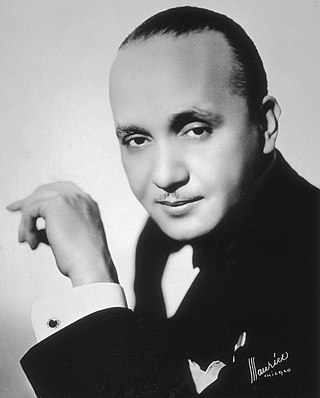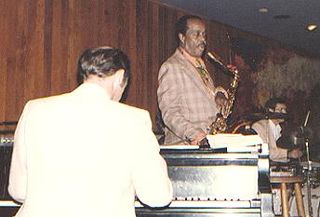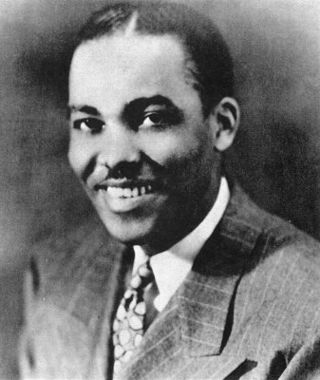Related Research Articles

A big band or jazz orchestra is a type of musical ensemble of jazz music that usually consists of ten or more musicians with four sections: saxophones, trumpets, trombones, and a rhythm section. Big bands originated during the early 1910s and dominated jazz in the early 1940s when swing was most popular. The term "big band" is also used to describe a genre of music, although this was not the only style of music played by big bands.

William James "Count" Basie was an American jazz pianist, organist, bandleader, and composer. In 1935, he formed the Count Basie Orchestra, and in 1936 took them to Chicago for a long engagement and their first recording. He led the group for almost 50 years, creating innovations like the use of two "split" tenor saxophones, emphasizing the rhythm section, riffing with a big band, using arrangers to broaden their sound, and others. Many musicians came to prominence under his direction, including the tenor saxophonists Lester Young and Herschel Evans, the guitarist Freddie Green, trumpeters Buck Clayton and Harry "Sweets" Edison, plunger trombonist Al Grey, and singers Jimmy Rushing, Helen Humes, Thelma Carpenter, and Joe Williams.

David Roy Eldridge, nicknamed "Little Jazz", was an American jazz trumpeter. His sophisticated use of harmony, including the use of tritone substitutions, his virtuosic solos exhibiting a departure from the dominant style of jazz trumpet innovator Louis Armstrong, and his strong impact on Dizzy Gillespie mark him as one of the most influential musicians of the swing era and a precursor of bebop.
Swing music is a style of jazz that developed in the United States during the late 1920s and early '30s. It became nationally popular from the mid-1930s. The name derived from its emphasis on the off-beat, or nominally weaker beat. Swing bands usually featured soloists who would improvise on the melody over the arrangement. The danceable swing style of big bands and bandleaders such as Benny Goodman was the dominant form of American popular music from 1935 to 1946, known as the swing era, when people were dancing the Lindy Hop. The verb "to swing" is also used as a term of praise for playing that has a strong groove or drive. Musicians of the swing era include Duke Ellington, Benny Goodman, Count Basie, Cab Calloway, Jimmy Dorsey, Tommy Dorsey, Woody Herman, Harry James, Lionel Hampton, Glenn Miller, Artie Shaw, Jimmie Lunceford, and Django Reinhardt.

James Fletcher Hamilton Henderson was an American pianist, bandleader, arranger and composer, important in the development of big band jazz and swing music. He was one of the most prolific black musical arrangers and, along with Duke Ellington, is considered one of the most influential arrangers and bandleaders in jazz history. Henderson's influence was vast. He helped bridge the gap between the Dixieland and the swing eras. He was often known as "Smack" Henderson.

The Jazz Age was a period in the 1920s and 1930s in which jazz music and dance styles gained worldwide popularity. The Jazz Age's cultural repercussions were primarily felt in the United States, the birthplace of jazz. Originating in New Orleans as mainly sourced from the culture of African Americans, jazz played a significant part in wider cultural changes in this period, and its influence on popular culture continued long afterwards.
The swing era was the period (1933–1947) when big band swing music was the most popular music in the United States. Though this was its most popular period, the music had actually been around since the late 1920s and early 1930s, being played by black bands led by such artists as Duke Ellington, Jimmie Lunceford, Bennie Moten, Cab Calloway, Earl Hines, and Fletcher Henderson, and white bands from the 1920s led by the likes of Jean Goldkette, Russ Morgan and Isham Jones. An early milestone in the era was from "the King of Swing" Benny Goodman's performance at the Palomar Ballroom in Los Angeles on August 21, 1935, bringing the music to the rest of the country. The 1930s also became the era of other great soloists: the tenor saxophonists Coleman Hawkins, Ben Webster and Lester Young; the alto saxophonists Benny Carter and Johnny Hodges; the drummers Chick Webb, Gene Krupa, Jo Jones and Sid Catlett; the pianists Fats Waller and Teddy Wilson; the trumpeters Louis Armstrong, Roy Eldridge, Bunny Berigan, and Rex Stewart.

The Mills Blue Rhythm Band was an American big band active during the 1930s.

The Count Basie Orchestra is a 16- to 18-piece big band, one of the most prominent jazz performing groups of the swing era, founded by Count Basie in 1935 and recording regularly from 1936. Despite a brief disbandment at the beginning of the 1950s, the band survived long past the big band era itself and the death of Basie in 1984. It continues under the direction of trumpeter Scotty Barnhart.
Walter Sylvester Page was an American jazz multi-instrumentalist and bandleader, best known for his groundbreaking work as a double bass player with Walter Page's Blue Devils and the Count Basie Orchestra.

Kansas City jazz is a style of jazz that developed in Kansas City, Missouri during the 1920s and 1930s, which marked the transition from the structured big band style to the much more improvisational style of bebop. The hard-swinging, bluesy transition style is bracketed by Count Basie, who in 1929 signed with Bennie Moten's Kansas City Orchestra, and Kansas City native Charlie Parker, who ushered in the bebop style in America. It has been said that while New Orleans was the birthplace of jazz, "America's music" grew up in Kansas City.

George Holmes "Buddy" Tate was an American jazz saxophonist and clarinetist.

Albert J. "Budd" Johnson III was an American jazz saxophonist and clarinetist who worked extensively with, among others, Ben Webster, Benny Goodman, Big Joe Turner, Coleman Hawkins, Dizzy Gillespie, Duke Ellington, Quincy Jones, Count Basie, Billie Holiday and, especially, Earl Hines.

George Duvivier was an American jazz double-bassist.
Orchestral jazz or symphonic jazz is a form of jazz that developed in New York City in the 1920s. Early innovators of the genre, such as Fletcher Henderson and Duke Ellington, include some of the most highly regarded musicians, composers, and arrangers in all of jazz history. The fusion of jazz's rhythmic and instrumental characteristics with the scale and structure of an orchestra, made orchestral jazz distinct from the musical genres that preceded its emergence. Its development contributed both to the popularization of jazz, as well as the critical legitimization of jazz as an art form.
Territory bands were dance bands that crisscrossed specific regions of the United States from the 1920s through the 1960s. Beginning in the 1920s, the bands typically had 8 to 12 musicians. These bands typically played one-nighters, six or seven nights a week at venues like VFW halls, Elks Lodges, Lions Clubs, hotel ballrooms, and the like. Francis Davis, jazz critic for The Village Voice, likened territory bands to "the Top 40 cover bands of their day, typically relying on stock arrangements of other ensembles' hits." He said, "many historians give much credit to territory bands for popularizing modern ballroom dancing that began during the World War I era with the influence of Vernon and Irene Castle."

Joseph Copeland Garland was an American jazz saxophonist, composer, and arranger, best known for writing "In the Mood".
Edgar "Puddinghead" Battle was an American jazz multi-instrumentalist, composer, and arranger. He performed on trumpet, trombone, saxophone, and keyboard.
Lester Rallingston "Shad" Collins was an American jazz trumpet player, composer and arranger, who played in several leading bands between the 1930s and 1950s, including those led by Chick Webb, Benny Carter, Count Basie, Lester Young, Cab Calloway and Sam "The Man" Taylor.

Early Jazz: Its Roots and Musical Development, by Gunther Schuller, is a seminal study of jazz from its origins through the early 1930s, first published in 1968. It has since been translated into five languages. When it was published, it was the first volume of a projected two volume history of jazz through the Swing era. The book takes an enthusiastic tone to its subject. A notable feature of the series is transcriptions of jazz performances, which increase its value for the musically literate.
References
- 1 2 3 4 5 6 7 8 9 Colin Larkin, ed. (1992). The Guinness Encyclopedia of Popular Music (First ed.). Guinness Publishing. p. 2631/2. ISBN 0-85112-939-0.
- 1 2 3 George Washington at AllMusic
- ↑ Gunther Schuller, The Swing Era: The Development of Jazz, 1930-1945 (Oxford University Press, 1989; ISBN 0199874395), p. 387 n. 17; both named tunes are Mills Blue Rhythm Band, 1933.